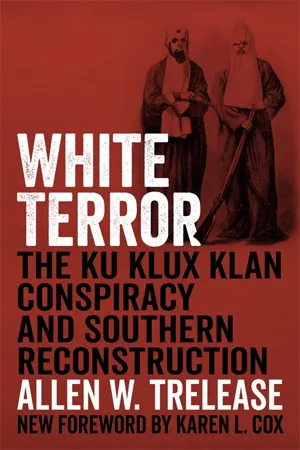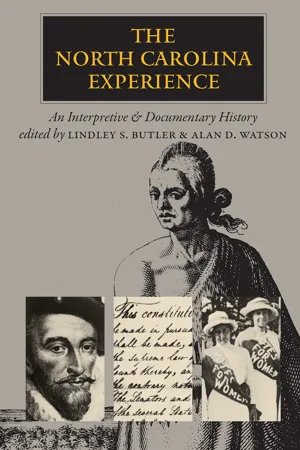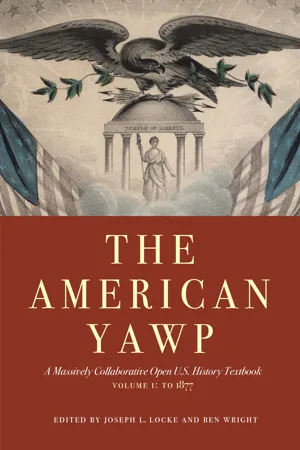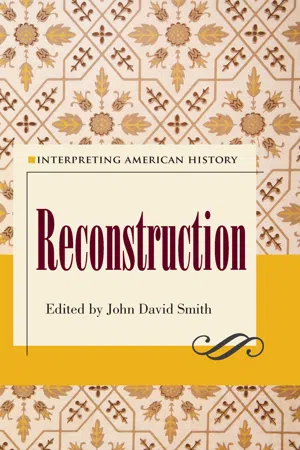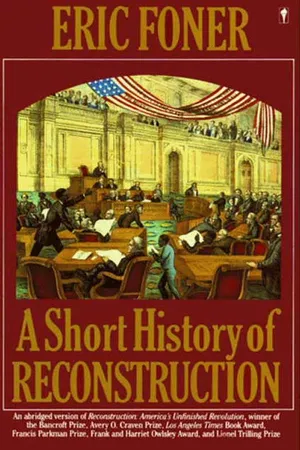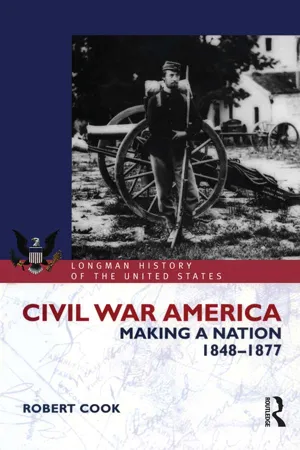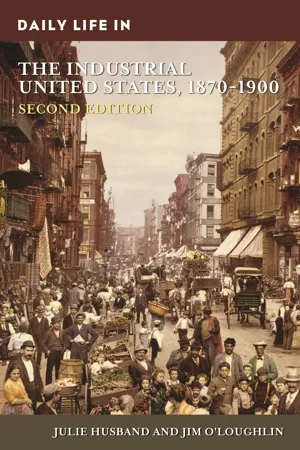History
Radical Reconstruction
Radical Reconstruction refers to the period following the American Civil War when the Republican-led Congress implemented sweeping reforms in the South. These reforms aimed to address the social, economic, and political inequalities faced by African Americans, including the passage of the 13th, 14th, and 15th Amendments. Radical Reconstruction also saw the establishment of biracial governments in the South and the expansion of civil rights for formerly enslaved individuals.
Written by Perlego with AI-assistance
Related key terms
11 Key excerpts on "Radical Reconstruction"
- eBook - ePub
White Terror
The Ku Klux Klan Conspiracy and Southern Reconstruction
- Allen W. Trelease(Author)
- 2023(Publication Date)
- LSU Press(Publisher)
73The Radical revolution, as some contemporaries on both sides regarded it, was only a halfway revolution. Within the South, Radical Reconstruction was clearly revolutionary in its overthrow of the old ruling class and above all in its establishment of political and legal equality for Negroes; hence the bitterness of the Conservative reaction. But economically and socially there was far less change, and most blacks remained a landless peasantry subject to manifold discrimination. In the larger national context, Radical Reconstruction reflected a revival of the old nationalistic constitutional doctrine of Hamilton and Marshall submerged by the state rights creed of Jefferson, Jackson, and their successors before 1860. The Radicals were not revolutionary by traditional American standards; if they appeared to be so it was chiefly because of the archaic social and political structure of the South. Nor did most of them regard themselves as revolutionaries. Southern Republicans, in trying to broaden their base of support at home, denied the charge and sought repeatedly to identify themselves with established political traditions. They claimed to stand for state rights within the higher national context and for the libertarian doctrines expressed in the Declaration of Independence. The Fourteenth and Fifteenth Amendments, the Reconstruction Acts, the civil rights legislation, and other related laws attempted to guarantee Negro rights and a loyal South within the accepted federal framework set forth in the Constitution. National authority and military rule were applied only partially and temporarily after 1865, and often reluctantly at that. The chief reliance in day-to-day government rested on the existing civil authorities. When the new state governments were formed after 1867, national and military control were withdrawn and the new regimes had to rely for their survival on customary legal institutions. - eBook - ePub
The North Carolina Experience
An Interpretive and Documentary History
- Lindley S. Butler, Alan D. Watson(Authors)
- 2010(Publication Date)
- The University of North Carolina Press(Publisher)
Chapter 13Reconstruction
The Halfway Revolution Allen W. TreleaseGenerals Steedman and Fullerton Conferring with Freedmen at the Trent River Settlement, Harper’s Weekly, 9 June 1866 (Courtesy of the Division of Archives and History, Raleigh, N.C.)No period in American history has undergone a greater change in historical interpretation than the Reconstruction era. This change resulted from the civil rights movement (or Second Reconstruction) of the 1950s and 1960s. Older treatments of Reconstruction rested on whitesupremacist assumptions that could no longer be accepted. Historians took a new and more appreciative look at Thaddeus Stevens, Charles Sumner, and the other Radical Republicans of the 1860s, who strove to guarantee a genuine freedom and equality for black people. Occasionally the historiographical reaction may have gone too far, idealizing men who (like their opponents) were often motivated by partisan and personal considerations as well as humanitarian ones. But the new view has endured, with successive refinements of detail and interpretation.The Republican party not only led the Union to victory in the Civil War but also assumed almost exclusive responsibility for the abolition of slavery in the face of indecisiveness or outright opposition by northern Democrats. In 1865, therefore, Republicans had some reason to see their party as the indispensable safeguard of the Union and the blacks, and a political defeat would imperil the military victory just won at the cost of four years of death and sacrifice. A quick restoration of the South, with no conditions attached beyond an oath of future loyalty, threatened to let former Confederates resume the position they had held in 1861 when they broke their former oaths of loyalty. Who, then, would protect the black population against new forms of servility and exploitation, no longer called slavery but closely resembling it? Who would keep the men in gray from returning to Washington and taking over the federal government in alliance with northern Democrats, who had previously supported them to the verge of secession? Unless preventive measures were taken, the former rebels would actually gain power in Congress and the electoral college as a result of the Republican policy of emancipation. (Southern states had been able to count three-fifths of their slaves for purposes of representation; now five-fifths of the blacks would be counted, yet virtually no southerner proposed giving them any vote or voice in government.) Republicans were determined not to see the Civil War end that way. They differed, however, in how far they would go to prevent it. - No longer available |Learn more
- (Author)
- 2013(Publication Date)
- Wiley-Blackwell(Publisher)
6 The Era of Reconstruction, 1865–1876What was to be the agenda for the country's future now that the Civil War had ended? Even the victorious Republican Party of the North held divergent views. One element within the party gave uppermost importance to granting citizenship to the newly freed slaves. These Radical Republicans, as they came to be called, were a distinct minority within the party in 1865, and they advocated extending full civil rights to ex-slaves, among them the franchise, education, and, possibly, ownership of confiscated Rebel land. Another, more moderate, faction within the Republican Party principally pursued economic development. During the course of the war, moderate Republicans succeeded in enacting a protective tariff, a plan of internal improvements (that is, improving transportation networks), a national banking system, and a homestead law that permitted the rapid settlement of the West. Backers of this agenda sought to keep southerners from undermining the vibrancy of an expanding national economy by their opposition to the new programs, their insistence on states' rights (the cornerstone of southern politics) and their demands for other concessions. Northern Democrats, not to be dismissed from determining the course of the nation, held still other views on the future of the postbellum United States. Nevertheless, nearly all Republicans believed that African Americans should, at the very least, have some measure of equality under the law.In April 1865, the war moved from the battlefield to the political arena. Texans, as did other southerners, sought to reestablish the Democratic rule that held sway before the war. Most urgent, for them, was to find a way to keep a newly freed black population (estimated by scholars to have numbered about 250,000) in subordination. In the differing goals of Republicans and southern Democrats lay the seeds of division and confrontation that would mark the era of Reconstruction. - eBook - ePub
Liberty's Surest Guardian
American Nation-Building from the Founders to Obama
- Jeremi Suri(Author)
- 2011(Publication Date)
- Free Press(Publisher)
Too often we treat these moments in this way. Instead, Reconstruction was “the beginning of the war”—an uncertain opening into a more extensive world of nation-states, and a closure for other hybrid and partial forms of governance from the past. For all its limits, Reconstruction set the American South, the United States, and many other parts of the globe on a new trajectory. It ended any serious effort at defining a “sectional” political system that challenged the unity of a single people, an integrated economy, and a common public culture that spanned such a large and diverse territory. Reconstruction affirmed that there would be only one American nation in rhetoric and in daily practice. 16 The destruction of the Confederacy extinguished the claims that a large portion of the population could live a distinctive social and economic life—slavery amidst free market industrial capitalism, plantation aristocracy amidst individualism and corporate power. Diversity and exception within the larger body politic were no longer tolerated on this scale. Reconstruction created a more homogenous definition of the “people” and the “government” that could speak for them. It forced a universal model of the nation-state on the diverse communities of the United States. A more centralized federal government, with powers far exceeding those that Madison or Hamilton could conceptualize two generations earlier, now managed life across this vast nation. This was the modern nation-state in action. National bureaucracy, a professionalized military, and a tradition of intervention replaced localism, antimilitarism, and isolation. Standardization and unity trumped diversity and independence. Reconstruction solidified order, stability, and growth among a single people tied to a single territory - eBook - ePub
- Robert A. Calvert, Arnoldo De Leon, Gregg Cantrell(Authors)
- 2020(Publication Date)
- Wiley-Blackwell(Publisher)
6 The Era of Reconstruction, 1865–1876What was to be the agenda for the country’s future now that the Civil War had ended? Even the victorious Republican Party of the North held divergent views. One element within the party gave uppermost importance to granting citizenship to the newly freed slaves. These Radical Republicans, as they came to be called, were a distinct minority within the party in 1865, and they advocated extending full civil rights to ex‐slaves, among them the franchise, education, and, possibly, ownership of confiscated Rebel land. Another, more moderate, faction within the Republican Party principally pursued economic development. During the course of the war, moderate Republicans succeeded in enacting a protective tariff, a plan of internal improvements (that is, improving transportation networks), a national banking system, and a homestead law that permitted the rapid settlement of the West. Backers of this agenda sought to keep southerners from undermining the vibrancy of an expanding national economy by their opposition to the new programs, their insistence on states’ rights (the cornerstone of southern politics), and their demands for other concessions. Northern Democrats, not to be dismissed from determining the course of the nation, held still other views on the future of the postbellum United States. Nevertheless, nearly all Republicans believed that African Americans should, at the very least, have some measure of equality under the law.In April 1865, the war moved from the battlefield to the political arena. Texans, as did other southerners, sought to reestablish the Democratic rule that held sway before the war. Most urgent, for them, was to find a way to keep a newly freed black population (estimated by scholars to have numbered about 250,000) in subordination. In the differing goals of Republicans and southern Democrats lay the seeds of division and confrontation that would mark the era of Reconstruction. - eBook - ePub
The American Yawp
A Massively Collaborative Open U.S. History Textbook, Vol. 1: To 1877
- Joseph L. Locke, Ben Wright(Authors)
- 2019(Publication Date)
- Stanford University Press(Publisher)
15 ReconstructionI. IntroductionContrabands , Cumberland Landing, Virginia, 1862. Library of Congress.After the Civil War, much of the South lay in ruins. “It passes my comprehension to tell what became of our railroads,” one South Carolinian told a northern reporter. “We had passably good roads, on which we could reach almost any part of the State, and the next week they were all gone—not simply broken up, but gone. Some of the material was burned, I know, but miles and miles of iron have actually disappeared, gone out of existence.”1 He might as well have been talking about the entire antebellum way of life. The future of the South was uncertain. How would these states be brought back into the Union? Would they be conquered territories or equal states? How would they rebuild their governments, economies, and social systems? What rights did freedom confer on formerly enslaved people?The answers to many of Reconstruction’s questions hinged on the concepts of citizenship and equality. The era witnessed perhaps the most open and widespread discussions of citizenship since the nation’s founding. It was a moment of revolutionary possibility and violent backlash. African Americans and Radical Republicans pushed the nation to finally realize the Declaration of Independence’s promises that “all men are created equal” and have “certain unalienable rights.” White Democrats granted African Americans legal freedom but little more. When black Americans and their radical allies succeeded in securing citizenship for freedpeople, a new fight commenced to determine the legal, political, and social implications of American citizenship. Resistance continued, and Reconstruction eventually collapsed. In the South, limits on human freedom endured and would stand for nearly a century more.II. Politics of ReconstructionReconstruction—the effort to restore southern states to the Union and to redefine African Americans’ place in American society—began before the Civil War ended. President Abraham Lincoln began planning for the reunification of the United States in the fall of 1863.2 With a sense that Union victory was imminent and that he could turn the tide of the war by stoking Unionist support in the Confederate states, Lincoln issued a proclamation allowing southerners to take an oath of allegiance. When just 10 percent of a state’s voting population had taken such an oath, loyal Unionists could then establish governments.3 - eBook - ePub
- John David Smith(Author)
- 2016(Publication Date)
- The Kent State University Press(Publisher)
CHAPTER THREERadical Reconstruction
SHEPHERD W. MCKINLEY
The historiography of Congressional, or as it is more popularly known, Radical, Reconstruction, has been a “dark and bloody ground” paralleling the arcs of race relations and politics in the United States.1 After Reconstruction’s end, the so-called Dunning School of historians, the students of Columbia University’s William A. Dunning, adopted the white South’s victimized voice, hanging (this time in effigy rather than by ropes) the Radical Republicans, providing the dominant historical interpretation of the period 1867–1877 for most of the twentieth century.Revisionist historians began attacking the Dunning interpretation in the 1930s and within three decades had rehabilitated Radical Reconstruction generally and the Radicals in particular. Federal intervention in racial questions and the civil rights laws of the 1960s seemed, to these historians, to justify Congressional Reconstruction. In fact, historians often label the modern civil rights movement as the Second Reconstruction. As the optimism of the civil rights movement faded in the 1970s and all but disappeared during Reagan’s America, a breed of so-called postrevisionist scholars discovered that the Radicals had not been so radical after all, that Radical Reconstruction had been a rather conservative affair. In 1988, historian Eric Foner reconciled the revisionist and postrevisionist viewpoints and ended the century-long debate over whether the era was a lost revolutionary moment (as described by liberals and progressives) or a chamber of horrors (as defined by conservatives and reactionaries). Although no post-postrevisionist historiographic school has yet emerged, recent historians have generally followed Foner’s lead, exploring previously neglected aspects of Radical Reconstruction. They underscore the Reconstruction Era’s essential complexity, again suggesting how historiography tends to mirror political and social thought at any given time. Today’s scholars argue that although Reconstruction defies facile conclusions, even an overall synthesis, close study of the topic nevertheless improves our understanding of this most wrenching period in American history. - eBook - ePub
- Eric Foner(Author)
- 2010(Publication Date)
- HarperCollins e-books(Publisher)
The Making of Radical ReconstructionIt was a peculiarity of nineteenth-century politics that more than a year elapsed between the election of a Congress and its initial meeting. The Thirty-Ninth Congress, elected in 1864 in the midst of war, assembled in December 1865 to confront the crucial issues of Reconstruction: Who would control the South? Who would rule the nation? What was to be the status of the emancipated slave? In both houses, Republicans outnumbered Democrats by better than three to one. The interaction between the Republican party’s distinctive factions would effectively determine the contours of Congressional policy.The Radical Republicans
On the party’s left stood the Radical Republicans, a self-conscious political generation with shared experiences and commitments, a grass-roots constituency, a moral sensibility, and a program for Reconstruction. At the core of Congressional Radicalism were men whose careers had been shaped by the slavery controversy: Charles Sumner, Benjamin Wade, and Henry Wilson in the Senate; Thaddeus Stevens, George W. Julian, and James M. Ashley in the House. With the exception of Stevens they represented constituencies centered in New England and the belt of New England migration that stretched across the rural North through upstate New York, Ohio’s Western Reserve, northern Illinois, and the upper Northwest. Here lay rapidly growing communities of family farms and small towns, where the superiority of the free labor system appeared self-evident, antebellum reform had flourished, and the Republican party commanded overwhelming majorities.The preeminent Radical leaders, Thaddeus Stevens and Charles Sumner, differed in personality and political style. The recognized floor leader of House Republicans, Stevens was a master of Congressional infighting, parliamentary tactics, and blunt speaking. One contemporary called him “a rude jouster in political and personal warfare.” Sumner, disliked by Senate colleagues for egotism, self-righteousness, and stubborn refusal to compromise, acted as the voice, the embodiment, of the New England conscience. Unconcerned with the details of committee work and legislative maneuvering, his forte lay in lengthy, erudite speeches in which he expounded the recurrent theme of his political career: equality before the law. Abolitionists considered him their politician. So too did - eBook - ePub
- Joseph E. Lowndes, Julie Novkov, Dorian T. Warren, Joseph E. Lowndes, Julie Novkov, Dorian T. Warren(Authors)
- 2012(Publication Date)
- Routledge(Publisher)
6 Reconstruction, race, and revolutionPamela Brandwein 1It is common today to regard the period of Reconstruction as a revolution, albeit an unfinished one.2 In the crucible of the 1860s, a war was fought, slavery was forbidden, birthright citizenship was established, and the principle of equality under law was enshrined in the Fourteenth Amendment. In 1870, the freedmen became members of the American political community, marking another momentous step in this critical era.3 If the architects of Reconstruction described themselves as “in the midst of a revolution,”4 this hardly seems surprising.But not all scholars accept the characterization of this turbulent era as revolutionary. An earlier body of historical work (Kelly 1966; Meier 1967; Benedict 1974; Paludan 1975; Litwack 1979) stresses the themes of racism, conservatism, and continuity with the antebellum order. Pointing to a persistent belief in white supremacy and emphasizing the limited commitment of Republicans to the freedmen, C.V. Woodward argues that Reconstruction was “essentially non-revolutionary and conservative” (Woodward 1979: 26). For Herman Belz, the Reconstruction Amendments were a “nonrevolutionary extension to black persons of guarantees of liberty and equality contained in the original Constitution” (Belz 1998: 13).My purpose here is not to referee this dispute. Rather, my goal is to begin thinking about the concept of revolution scholars use to debate the character of Reconstruction.5 These scholars, it turns out, work with a concept of revolution that lacks precision and rigor. To put the matter more bluntly, Reconstruction scholars are using the term revolution in a fairly sloppy way. Their thinly elaborated notion of revolution leaves undefined the criteria for distinguishing between revolution and reform. Unspecified, too, are the criteria or thresholds that mark the success of revolutionary efforts. This underspecification, in fact, permits the debate.6 - eBook - ePub
Civil War America
Making a Nation, 1848-1877
- Robert Cook(Author)
- 2014(Publication Date)
- Routledge(Publisher)
7WAR BY ANY OTHER NAME: THE STRUGGLE OVER RECONSTRUCTION, 1865–76
The welcome return of peace in the spring of 1865 witnessed a continuation of the wartime Reconstruction process that would resolve as yet unanswered questions about the relationships pertaining between state and federal governments, North and South, and blacks and whites. More specifically, it brought into sharper focus a problem that had bedeviled all postemancipation societies in the western hemisphere: how to effect a smooth transition between slavery and freedom. Because this problem was intertwined with the task of promoting national reconciliation and the strugglè to order power relations in the newly restored Union, the fraught politics of Reconstruction dominated American life in the decade after the Civil War.Lincoln’s successor in the White House, Andrew Johnson, undertook to restore the late Rebel states to their proper constitutional place inside the Union. His mistake was to underestimate the impact that the Civil War had had on the people of both sections. When it seemed apparent that Johnson’s lenient policies were allowing ex-Confederates to obstruct federal policy and regain their former influence through the ballot box, congressional Republicans attempted to promote at least a modicum of reform in the conquered South. Black suffrage made possible the sudden entry of black Americans into southern political life, a development that was contested fiercely by their former masters. Only as war memories began to fade and new issues began to preoccupy the country did Reconstruction come to an end.The aftermath of war
In his brief second inaugural address delivered on March 4, 1865 President Abraham Lincoln, chastened by God’s evident determination to punish Americans for the sin of slavery, announced that having fought a hard war, he would seek a generous peace. As his rousing peroration made clear, his overriding goal was national reconciliation: - Julie Husband, Jim O'Loughlin(Authors)
- 2019(Publication Date)
- Greenwood(Publisher)
This chapter considers the beliefs and practices that generated high participation rates across much of the country as well as the forces at play in suppressing black and Republican votes in the South. Because women were barred from voting in federal and most state and local elections, a specifically masculine culture developed, but women found means of indirectly influencing political culture and became some of the most ardent critics of the fraud and violence that marred it. Moreover, they became effective at pushing through public policy changes beneficial to women, children, and the working class.Through political participation, Americans addressed some of the new challenges facing an urbanizing and industrializing country. At the national level, the country was expanding on the transcontinental railroad, completed in 1869, with new routes that spawned rapid urban development. In social policy, it experimented with a pension system for Civil War veterans, their widows, and their children, and it restricted immigration for the first time. States and municipalities developed their own infrastructure to preserve the health and safety of urban dwellers—sewers, waterworks, trolley systems, electric streetlights, and tighter zoning to avoid fires. Finally, women activists and labor unions advanced policies aimed at protecting workers and offering greater security, though they met with significant resistance from large, powerful employers. By the end of the century, the federal government would weigh in on behalf of employers.Reconstruction in the SouthThe Civil War ended with the surrender of the eleven slave-holding states of the Confederacy in 1865, followed by a period of limited and somewhat ineffective rebuilding referred to as Presidential Reconstruction. A period of dramatic reorganization in the South, referred to as Congressional Reconstruction, began in 1868. Federal troops occupied the former Confederacy to administer these changes. For a brief period, until 1871, former Confederate soldiers were denied the vote in the South, resulting in a large Republican majority in Congress. Congress, dominated by “the party of Lincoln,” passed legislation establishing the Freedmen’s Bureau, which helped to resettle former slaves, sometimes offering them abandoned lands to cultivate and other times helping them to negotiate labor contracts with landowners. This help in negotiating contracts was crucial because former slaves owned no property, had to have work to survive, and were usually unable to read the contracts they signed, making them vulnerable to exploitation. The bureau also opened schools for African Americans. Expanded legal representation and education were costly compared with the limited government that had prevailed in the period prior to the Civil War. State governments across the South were funded by rising taxes on land. This on top of the debt many landowners had accrued during the war forced many to sell some or all of their land. In Edgefield, South Carolina, for example, landless white households increased from 25 percent in 1860 to 43 percent by 1870 (Kantrowitz 52).
Learn about this page
Index pages curate the most relevant extracts from our library of academic textbooks. They’ve been created using an in-house natural language model (NLM), each adding context and meaning to key research topics.
